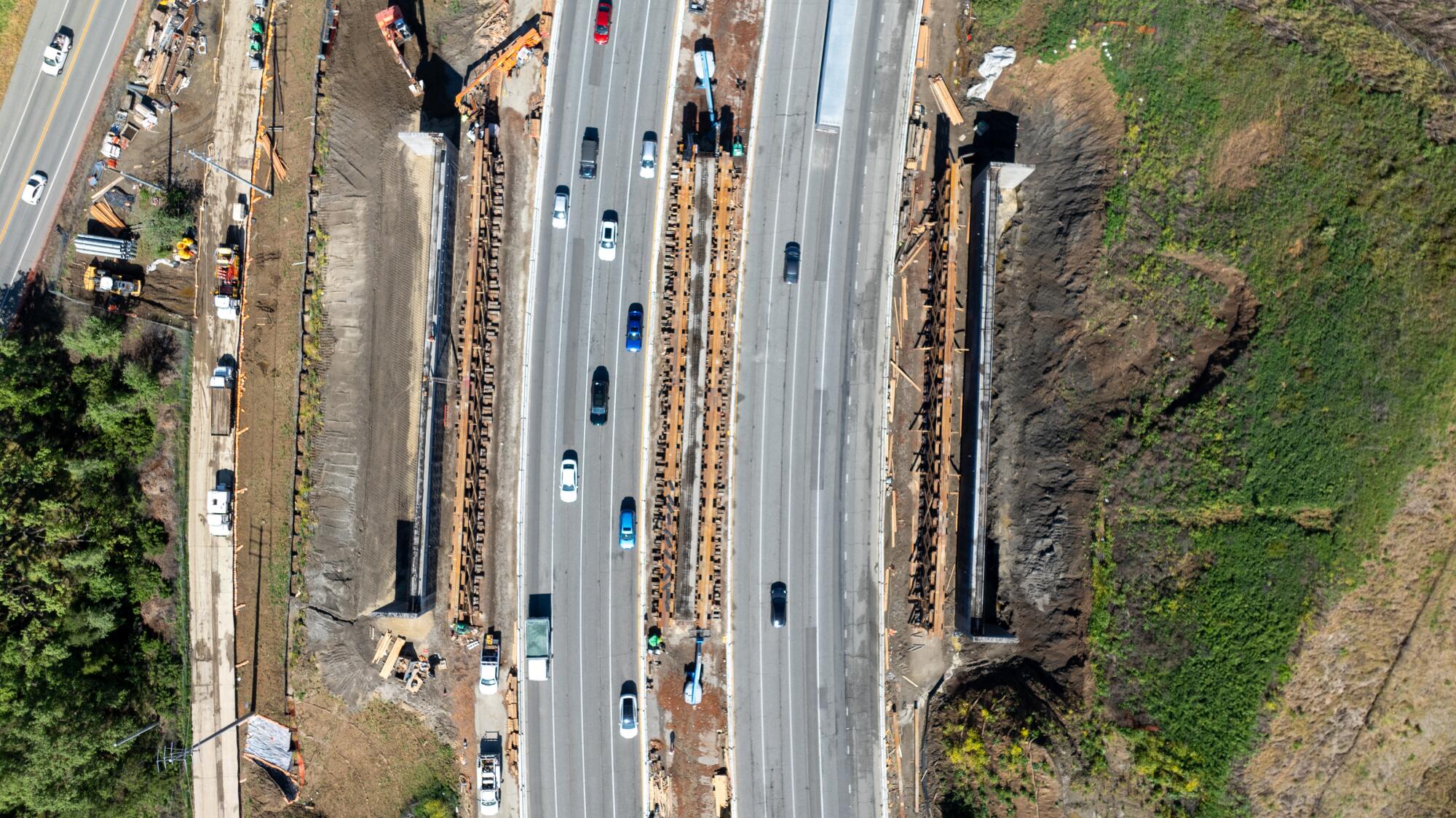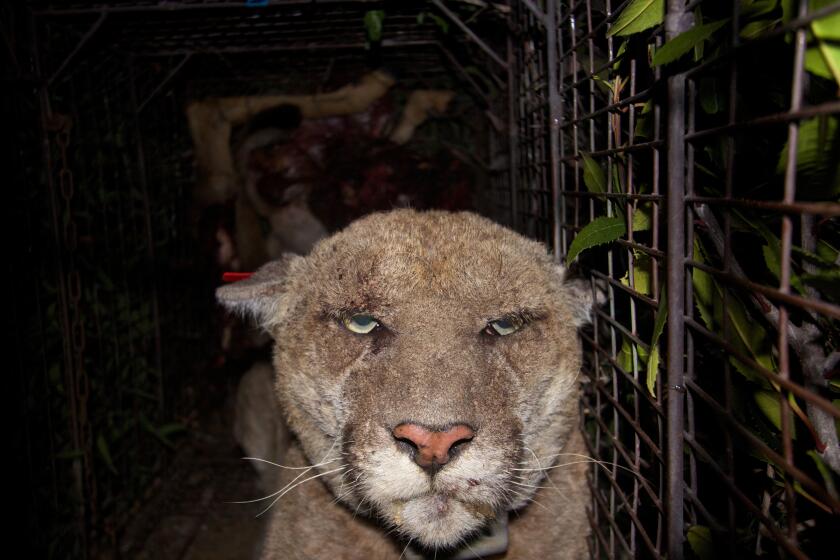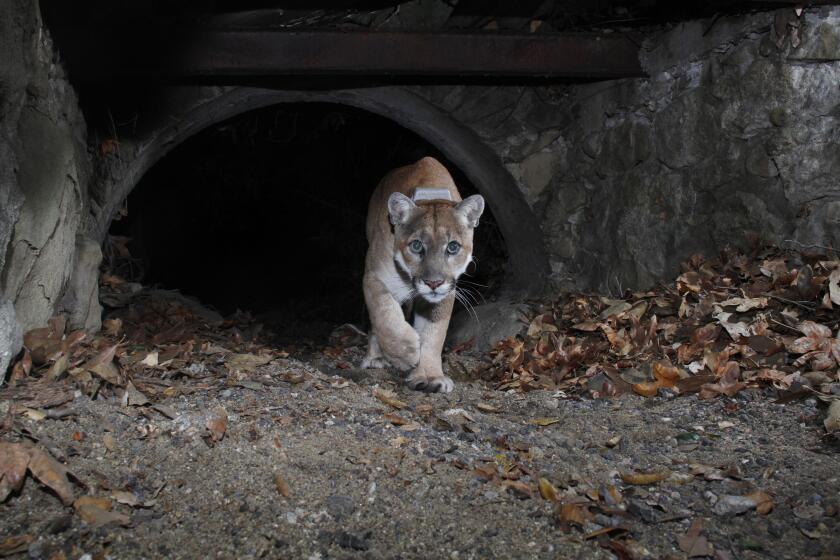
- Share via
- A new law directs local jurisdictions to consider and protect wildlife movement in their land-use plans.
- The effort builds on previous legislation that targeted animal passage and safety on state highways.
- The soonest cities and counties will need to comply with the requirements is Jan. 1, 2028.
Cities and counties must soon consider the impact of development on wildlife connectivity in their land-use plans following the passage of a law intended to promote safe travel across habitat fragmented by urban sprawl and freeways.
Gov. Gavin Newsom last week signed AB 1889, which directs local leaders to identify connectivity areas and then “avoid, minimize or mitigate” impacts to them so animals can rove unimpeded to find food, shelter and mates. Though not required, that could entail constructing crossings, erecting wildlife-safe fencing and setting aside land.
The law, dubbed the Room to Roam Act, “helps local officials plan for safer development so that California’s resilient wildlife has a chance to survive and thrive,” said J.P. Rose, urban wildlands policy director at the Center for Biological Diversity, which sponsored the bill.
By front-loading consideration of wildlife connectivity, “planners, builders and communities have a clearer picture of which areas are safer to build for both people and wildlife,” he said. The issue isn’t currently addressed until the end of the planning process.
Gov. Gavin Newsom has signed a bill that expands a moratorium on all types of a blood-thinning rat poison that has unintentionally sickened other animals.
Another top aim of the law is to loop cities and counties into a statewide effort to protect the movement of wildlife. Another successful law passed two years ago required the California Department of Transportation to make wildlife crossings a priority when it plans new road projects. But advocates feared a local government might greenlight development that stymied taxpayer-supported protections.
The latest legislation is an effort to “get everybody moving in the same direction,” Mari Galloway, California program director for the Wildlands Network, a co-sponsor of the bill, told The Times after the bill cleared the Legislature. Room to Roam requires local jurisdictions to identify existing and planned passages so they’re not undermined.
If successful, proponents say the law will help safeguard California’s biodiversity. For some animals, like genetically isolated mountain lions in Southern California’s Santa Monica and Santa Ana mountains, safe passage across whizzing freeways and concrete landscapes could stave off an extinction vortex.

Winston Vickers, former director of the California Mountain Lion Project at UC Davis Wildlife Health Center, said he sees the new law as “a natural extension” of the legislation focused on roadways.
“Because not only do roads impede movement of animals, but also development,” said Vickers, who is an associate research veterinarian at the center.
Vickers believes these efforts could help address inbreeding among pumas in the Santa Anas that are hemmed in by the I-15. Kinked tails and reduced semen quality have revealed that these mountain lions suffer from a restricted gene pool.
“It doesn’t take a lot, apparently, to help prevent the inbreeding from getting worse,” he said. It requires about one reproductive animal per generation — every two to four years — to cross the I-15. But that isn’t happening.
With regard to providing passage, “We would hope some improvement would certainly be better than none,” he said. (There are early-stage efforts to enhance connectivity for the lions underway.)
A mountain lion spotted at the edge of Griffith Park last month recalled the park’s former feline king, P-22. If the new cougar stays, he’ll face the same challenges as his predecessor.
Cities and counties decide where development goes based on long-term planning documents, known as general plans. But Assemblymember Laura Friedman (D-Glendale), author of AB 1889, said state law hasn’t provided clear guidance on how to address connectivity in their planning process.
Proponents of the new law say it will help to fill that gap.
“[W]ithout the Room to Roam Act, there is nothing requiring local governments to designate areas needed to keep landscapes intact for wildlife connectivity,” read a statement from Beth Pratt, California regional executive director for the National Wildlife Federation and a major force behind wildlife connectivity efforts.
Friedman, in a statement, highlighted the bill’s possible benefit to people as well as animals.
“It’s important that migrating animals are able to move through California without being struck and killed on our roadways or presenting a danger to humans,” she said, describing it as “a common sense planning bill that will save human and animal lives while also preserving our ecosystems.”
The public-private effort underpinning the largest wildlife crossing in the world, under construction near L.A., has inspired an initiative to replicate it across California.
Under the new law, local governments are required to address connectivity in their general plans the next time they update an element of their plan on or after Jan. 1, 2028.
The implementation date was pushed back three years in response to concerns raised by stakeholders, including the American Planning Assn.’s California Chapter. After the bill was amended, the association took a neutral stance but flagged concerns about the resources required to keep up with state mandates impacting local planning.
“Planners are attempting to keep pace with the level and scale of new planning-related laws that are passed year over year, however many jurisdictions simply lack resources, both in terms of funding and staff capacity, to keep up with the cumulative burden imposed by these new mandates,” Erik de Kok, vice president of policy and legislation of the association’s California Chapter, wrote in a letter to Friedman.
There are anticipated significant but unknown costs to cities and counties tasked with making the updates, according to the state Senate Appropriations Committee. These costs aren’t reimbursable by the state.
Efforts to boost wildlife connectivity in the Golden State have gained momentum in recent years. What’s billed as the largest wildlife crossing in the world is rising over a 10-lane freeway near Los Angeles, while this summer saw the launch of an initiative seeking to leverage public and private resources to build more safe passages for critters across the state. Federal legislation to support habitat connectivity was also introduced.
California lawmakers recently took aim at another top threat to wildlife: rat poison. Last week, Newsom signed a bill putting a moratorium on all blood thinning rat poisons, which travel up the food chain when predators eat dead or sickened rats.










